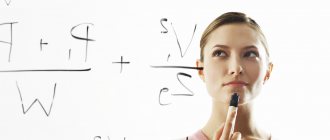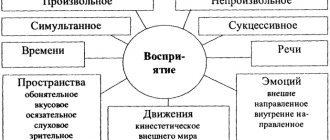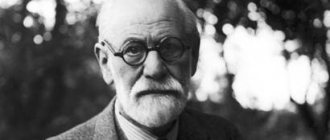As in the first type, they need to set themselves a special task in order to understand the essence of a phenomenon or adequately perceive any object. The stories of such people, as a rule, are filled with large details, behind which the meaning of the whole is often lost.
These two types of perception are characteristic of extreme poles; most often they complement each other. Their extreme variants cannot be considered as negative, because they determine the uniqueness of perception that gives a person the opportunity to be an extraordinary person.
Individual differences in perception and its development
Perception largely depends on the characteristics of a person. Knowledge, interests, habitual attitudes and emotional attitude towards what worries a person influence the process of perceiving objective reality. Since all people differ in their interests and views, as well as in a number of other characteristics, it can be argued that there are individual differences in perception.
Individual differences in perception are great, but, nevertheless, we can identify certain types of these differences that are characteristic not of a specific person, but of an entire group of people. Among them, first of all, are the differences between holistic and detailed or synthetic and analytical perception.
The holistic or synthetic type of perception is characterized by the fact that people prone to it have the most vivid general impression of the object, general perceptual content, and general features of what is perceived. People with this type of perception pay the least attention to details and trifles. They don't particularly emphasize them, and when they do, they don't do so first. Therefore, many details remain unnoticed by them. They grasp the meaning of the whole more than the detailed content and especially its individual parts. In order to see details, they must set themselves a special task, which is sometimes difficult for them.
People with a different type of perception, detailed or analytical, on the contrary, tend to notice details and features. This is what their perception is focused on. The object or phenomenon as a whole, the general meaning of what is perceived, fades into the background, and sometimes is not perceived at all. In order to understand the essence of a phenomenon or adequately perceive an object, they must set themselves a specific task, which they do not always manage to do. Their stories are always full of details and descriptions of individual details, behind which the meaning of the whole is often lost.
The above features of the two modes of perception are characteristic of the extreme poles. Most often, they complement each other, since perceptions based on the positive traits of both types are the most productive. However, extreme options should also not be considered negative, since they very often determine the specificity of perception that makes a person an exceptional person.
There are other types of perception, for example, descriptive and explanatory. People of the descriptive type limit themselves to the factual side of what they see and hear, and do not try to explain to themselves the nature of the phenomenon they perceive. The motivational forces behind people's actions, events or phenomena are beyond their attention. In contrast, people of the explanatory type are not satisfied with what is directly given by perception. They always try to explain what they see or hear. This type of behavior is most often combined with a holistic or synthetic type of perception.
There is also a difference between objective and subjective modes of perception. The objective type of perception is characterized by strict compliance with what is happening in reality. People with a subjective type of perception go beyond what is given to them in reality and add a lot of their own. Their perceptions are subject to subjectivity to what they perceive, increased evaluation bias, and pre-existing biases. Such people, when talking about something, strive to convey not what they perceive, but their subjective impressions about it. They talk more about how they felt or what they were thinking at the time of the events described.
Of great importance in individual differences in perception are differences in observation.
What is the type of perception?
The first thoughts about the peculiarities of perception are found in the works of ancient philosophers. Around the 6th century. BC e. thinkers began to notice differences in their students' perceptions and write down their observations. These differences were interpreted in different ways, but a start had been made.
It should be noted that until the 18th century. a person was considered by scientists as a part of society, which is understandable and logical. The approach to the study of personality psychology and the development of a theory that began to allow for the principle of personal benefit in a person and the assessment of all phenomena based on their usefulness and acceptance by an individual, from the psychologists Bentham and Smith. This moment became a turning point and finally turned the views of scientists in the right direction.
In the 19th–20th centuries. The period of development of social psychology began. Researchers began conducting laboratory experiments for the first time. It was this period that gave a clear understanding of the differences in people's perceptions. Tests were created whose purpose was to determine the way a person perceives information. Now a whole science called “Socionics” is studying these subtleties.
Regularities and properties of perceptions
A more complex form of mental reflection compared to sensations is perception, which forms in a person’s mind a holistic picture of an object, phenomenon, etc., when individual sensations merge and the entire process of perception moves from the reflection of individual features of an object to its reflection as a whole.
Thus, perception is a mental process of a holistic reflection of objects and phenomena in the totality of their properties and characteristics with the direct action of these objects on the senses.
Knowledge of the laws of the perception process in legal proceedings helps to better understand the mechanism of formation of the testimony of witnesses, victims, accused, etc., to assess the reliability of their testimony as evidence in the case.
Types and characteristics of perception. Depending on the leading role of a particular analyzer, there are different types of perception: visual, auditory, olfactory, gustatory, kinesthetic. In connection with the organization of the perception process, a distinction is made between voluntary (intentional) and involuntary perception.
The main characteristics and laws of perception are:
(a) objectivity, integrity, structure of perception. Various phenomena, objects endowed with different properties surround a person in everyday life. When we perceive them, we consider them as a whole. This perception has a regulatory influence on a person’s cognitive activity and the development of his perceptual abilities.
Unlike sensations, as a result of such meaningful perception, a holistic picture of an object or phenomenon is formed, including something as complex as a crime. Due to this pattern, in the absence of information, a person usually tries to independently fill in the missing elements of the perceived phenomenon, which sometimes leads to erroneous judgments. Therefore, when interrogating witnesses, victims, etc. it is necessary to find out not only what they saw and heard, but also on what basis their statements about certain features of the perceived object or phenomenon are based. Otherwise, the testimony of a witness (victim), “based on a hunch, assumption, rumor, as well as the testimony of a witness who cannot indicate the source of his consciousness,” is recognized as inadmissible evidence;
b) perceptual activity. As a rule, the process of isolating and synthesizing the features of an object is selective, purposeful and searching in nature. In this process there is an active, organizing principle that subordinates the entire process of cognition. Penetrating into the phenomenon under study, we group its features in different ways, highlight the necessary connections, which gives perception a conscious, active character. The activity of perception is expressed in the participation of the effector (motor) components of the analyzers: movement of the pupils of the eyes, hands during touch, movement of the body in space relative to the object being studied. When perceiving familiar objects, the perceptual process may be limited to a certain extent;
c) Sense of perception. This is one of its most important features, which shows the synthesis of perceptual and mental components. Since perception is closely related to thinking, it is almost always meaningful (L. S. Vygotsky), therefore perceptual activity is often close to “visual thinking” (A. R. Luria). We not only perceive, but also at the same time study the object of knowledge, try to understand it, find an explanation of its essence, classify the perceived object to a certain group, class of objects, generalize it, in one word.
Perception as an activity
Consideration of perception and its properties from the point of view of activity theory leads to the conclusion that perception is an active process. His subjective image is built and adjusted in the process of active interaction with the objectively existing environment. In essence, an image is a product of perception as cognition. After all, the result of perception is manifested in images, sensory and mental. “This can be formulated this way: knowledge, thought are not separated from the process of forming a sensory image of the world, but enter into it, being added to sensuality.”
A. N. Leontiev O. This objective world is revealed in the image as really existing, i.e. independent of the subject itself. But at the same time, the “external” world turns into “being for the subject.” This is impossible without the participation of the consciousness of the subject himself. “The special function of sensory images of consciousness is that they give reality to the conscious image of the world as it is revealed to the subject. In other words, through the sensory content of consciousness, the world appears to the subject as existing not in consciousness, but outside consciousness - as an objective “field” and the object of its activity.”
Perception reveals a life process that occurs at different levels of the organization. Perception cannot be understood as a unidirectional process - from object to subject. There is also feedback created by activity, consciousness and will. The process of perception and its product are contained in activity in the objective surrounding world. And perception is as subjective as the perceived world. One of the most important properties of perception is its subjectivity. The objectivity of perception is expressed in the so-called act of objectification, that is, the attribution of information received from the outside world to this world. Without this attribution, perception cannot perform its orienting and regulatory function in human practical activity. Objectivity of perception is not an innate property. There is a certain system of actions that allows the subject to discover the subjectivity of the world. Touch and movement play a decisive role in this process. "THEM. Sechenov emphasized that subjectivity is formed on the basis of processes that ultimately are always external motor and establish contact with the object itself. Without movement, our perceptions would not have the property of being objectified, that is, associated with objects of the external world. Stratton's experiments with glasses that rotate the world 180 degrees showed that when a subject independently moves in an “inverted world,” he quickly adapts and begins to adequately navigate the environment, and his vision begins to “function” properly. And for those subjects who were thrown into an “upside-down world,” which deprived them of independent activity, the correct vision of the world was not restored. “All subjects showed a significant degree of adaptation in the series with active movement. In contrast, no adaptation was found in the passive movement series.” Subjectivity also plays a big role in the further formation of the perceptual processes themselves. When a discrepancy arises between the external world and its image, the subject is forced to look for new ways of perception that provide a more correct image.
Perception itself can be considered as an activity, that is, as a process caused and directed by one or another object, a motive that specifies a need. Perceptual activity is always determined by meaning, motive, purpose. He is endowed with the necessary abilities and normal functioning of psychophysiological functions. According to A.N. Leontiev, the activity of perception is revealed in “perception”. It is itself determined by meaning and has meaning. “Moving on to man, to human consciousness, I must introduce one more concept - the concept of the fifth quasi-dimension, in which the objective world is revealed to man. This is a field of meanings, a system of meanings”[8]. The meaningfulness of perception is an essential property of perception and proves its active nature.
Basic qualities of perception
The concepts of “sensation” and “perception” are interrelated, but there are fundamental differences between them. The essence of sensory processes lies in reflecting only individual properties of objects and phenomena of the world around us. However, a person does not live in a world of isolated spots of light or color, sound or touch, but in a world of things, objects and forms, in a world of complex situations. Everything that he perceives is always presented to him in the form of holistic images.
Perception includes sensations and is based on them. But it is a mistake to believe that it is simply the sum of individual perceptions. This process is much more complicated. It includes previous experiences, processes of thinking about what is perceived, memory and thinking. That is why it is often called the human perceptual system.
Perception is the mental process of reflecting objects and phenomena in the totality of their various properties and parts under the direct influence of organs.
Perception depends on the mental characteristics of a person. Some things are important to him now, and some are secondary. What is in the center of attention is called the object (subject) of perception, everything else is called the background. These elements are dynamic; they can change places.
The properties of perception include apperception, constancy, integrity, objectivity, structure, meaningfulness, and activity.
Perception depends on past experience and the content of a person’s mental activity. This property is called apperception. When the brain receives incomplete or contradictory data, it usually interprets them in accordance with an already established system of images and knowledge.
For example, kittens raised in a cage with bars oriented vertically were later unable to recognize horizontal lines. The Aleuts, who lived in round dwellings, found it difficult to navigate our houses with an abundance of vertical and horizontal lines.
The next property of perception is constancy. This is the relative constancy of certain properties of objects when the conditions of their perception change.
For example, we still perceive a distant moving truck as a large object even though its retinal image is much smaller than its image when we stand next to it.
The greatest constancy is observed in the visual perception of color, size and shape of objects.
For example, a piece of coal on a sunny summer afternoon is about 8-9 times lighter than chalk at dusk. But we perceive its color as black, not white. At the same time, the color of chalk will be white for us even at dusk.
Unlike perception, during sensation a holistic picture of an object is formed. Integrity is expressed in the fact that even with incomplete reflection of individual properties of the perceived object, a holistic picture of a specific object is mentally built.
The structure lies in the fact that in most cases perception is not a projection of momentary sensations. Rather, we perceive a generalized structure that develops over time.
For example, when a person hears a melody, the previously heard notes are still present in his mind when the information to sound a new note arrives. The listener usually understands the melody, that is, perceives its structure as a single whole.
Observation
Observation is understood as the ability to notice in objects and phenomena that which is little noticeable in them and does not catch the eye by itself. A sign of observation is the speed of perception of something subtle. This skill is not typical for all people and to varying degrees.
Differences in observation mainly depend on individual abilities. It is she who is the factor that contributes to its development.
There are differences in perception based on the degree of intentionality:
- Intentional - voluntary perception. From the very beginning, it is regulated by the task - to perceive this or that object, to become familiar with it. It can be included in some activity and carried out during its implementation, but it can also act as an independent activity;
- Unintentional or involuntary perception. With this perception, a person is not guided by a predetermined goal of perceiving a given object. Perception is directed by external circumstances.
Like perception, observation is not an innate characteristic. A newborn child cannot perceive the world around him as a whole objective picture. This ability appears much later.










